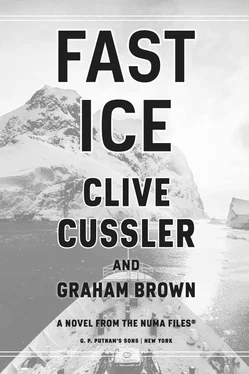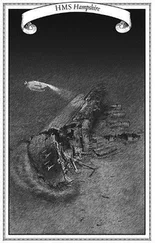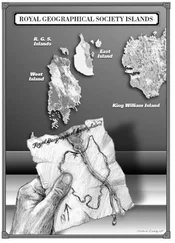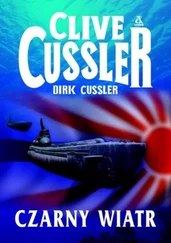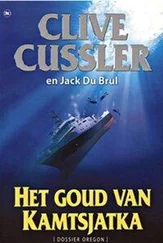He found three men inside, one of them at the wheel, the other two squinting through the port windows, looking out into the smoke.
All three turned with a start. One of them charged at Kurt, but Kurt swung the launch tube around, catching the man in the side of the head. The sailor tumbled to the deck and lay still.
The remaining two stared at Kurt in shock. Their attention went from his face to the pointed end of the harpoon that was aimed directly at them.
Kurt targeted the man with the more impressive uniform. “Tell your men to surrender.”
For effect, he switched the safety off, causing several lights to illuminate on the trigger housing.
The helmsman raised his hands and stood back from the wheel. Kurt nodded, making sure to look pleased. The captain stood stubbornly, so Kurt reached toward the panel, grabbed the microphone that connected to the ship’s PA system and tossed it to him.
The captain got the picture. He took the microphone, switched the selector to shipwide and gave the order to stop fighting.
Kurt stood there, keeping the captain under guard, as Zama and his men disarmed and secured the Chinese crew. It took several minutes. Once it was done, Lieutenant Zama made his way to the bridge.
He pulled the door open and stopped. He stood there in shock, staring at Kurt, then glancing back toward the patrol boat and then turning to Kurt again.
“What . . .” he began. “When . . . How . . .” Shaking his head in disbelief, the lieutenant got ahold of himself. “You’re supposed to be on the patrol boat.”
Kurt shrugged. “I got caught up in the excitement,” he said. “And I figured you and your men could use a hand.”
“How did you even get over here?”
“Pirate-style,” Kurt said. “I came over on the outstretched boom.”
Zama laughed heartily. “Of course you did.” He laughed again. “Okay,” he said. “Very good. Next time, you can go first.”
Kurt found that offer acceptable. “Now,” he said. “Let’s find out what these men were hiding.”
37
With the South African crew in control of the Chinese trawler, the patrol boat circled back and recovered the commandos who’d fallen into the sea. One of the men had a dislocated shoulder. The other two were uninjured and happy to rejoin the boarding party.
As the tactical team kept the trawler’s crew under guard, Kurt and Zama searched the ship from top to bottom. Making their way to the hold, the smell of fish became overpowering.
“This is why they ran,” Zama said.
They’d come to the trawler’s processing deck. Heaps of recently captured tuna filled the deck, some as large as ten feet long from nose to tail. “Each one of these bluefin is worth a hundred thousand dollars.”
Kurt nodded. He knew the price of tuna had soared in recent years. Especially for the larger fish. But tuna wasn’t all the ship held. In addition, they found dolphin carcasses and hundreds of fins cut from captured sharks, the bodies of which had been tossed overboard after the de-finning.
“What a waste,” Kurt said. It was one thing to fish, even for sharks and dolphins, but shark finning was decimating the world’s shark population. And taking out apex predators was known to cause disastrous effects on the food chains on land and in the sea.
To Kurt, it was no different than the killing of rhino and elephants for their horns and tusks, no different than the wholesale slaughter of the world’s tigers so their claws could be ground into powder for superstitious people to use in all manner of ridiculous ways.
“So much of humanity is foolish and shortsighted,” Zama said.
Kurt stood there quietly, looking at all that was left from a hundred dead sharks. More certainly needed to be done to protect the world’s ecological balance and save threatened species. But there was no call for cataclysmic plans like that of Ryland and his sister, which would destroy half the planet or more in the process.
He turned away. “Let’s finish checking the ship.”
“And then what?”
“Can you spare a skeleton crew?” Kurt asked.
“Prize crew for this ship? Of course. But what are you going to do with it?”
“I’m going to point the bow south and let her run.”
38
HERMES 51
OVER THE GREAT SOUTHERN OCEAN
The sun flared through glass panels of the cockpit as the P-8 Poseidon banked into a turn at thirty-seven thousand feet. Commander Walter Hansen squinted and glanced down at the instrument panel so as not to take the full brunt of the sunlight.
“Turning right to a heading of one-eight-zero,” he called out.
“Roger that,” a voice replied over the intercom. “Continue on heading one-eight-zero, until I call out the mark.”
From a distance the Poseidon looked like a modified Boeing 737, which it was. But that was the exterior. Inside, the aircraft was packed with advanced electronic equipment, sensors and various types of detectors, which the tactical systems operators used to track hostile submarines.
These operators occupied a section in the center of the aircraft, where comfortable, padded seats were bolted to the floor in front of an expanse of computer terminals, with multiple screens, keyboards, joysticks and mouses.
The aft section of the Poseidon was normally taken up by wine racks, which were cradles with slots in the side where sonobuoys were stored. These buoys were free-floating sensors that could be dropped from the aircraft into the sea, where they would listen for the sounds made by hidden submarines.
But the wine racks had been removed from this particular aircraft. Replacing them was a high-intensity, millimeter-wave radar unit known as an SPS, or a surface-penetrating system.
Hansen and his crew were the first to fly this model and had been testing it for months.
“Please climb to new altitude of four-one-thousand,” the voice over the intercom said.
The request came not from air traffic control but from Lieutenant Rebecca Collier, the recon systems operator who occupied the first row of the seats in the back of the aircraft.
Though Hansen was the pilot and commanding officer, it was Collier who would call the shots during the data-gathering leg of the flight.
When Hansen didn’t reply, Collier seemed to grow nervous, adding, “If that’s okay with you, sir.”
Hansen grinned. Collier was green. She had a master’s degree in electronic something or other and was fresh out of OCS and two separate radar schools. She was a young high-tech expert stuck in a unit filled with crusty fifteen-year vets.
So far, she’d held her own. But she hadn’t yet grown comfortable enough to crack a joke. Hansen was fine with that. He’d tell the lieutenant when it was her time to be funny. “Roger that, Lieutenant, climbing to flight level four-one-thousand.”
Hansen pulled back on the control column and brought the nose up. With the aircraft climbing smoothly, Hansen glanced out at the ocean and the frozen continent beyond. “We’ll be over the ice in five minutes.”
“Which begs the question,” Collier said. “What, exactly, are we doing here, sir? Aren’t we supposed to be hunting submarines?”
Hansen had been wondering that himself. Since the end of World War II, the American surface fleet had reigned supreme, leading opponents to concentrate their efforts on building submarines.
The Soviet Union had built a massive underwater fleet during the Cold War. Their designs included the largest, the fastest and the deepest-diving subs ever to prowl the depths.
In the last decade, the Chinese had taken a similar path, constructing entire fleets of modern submarines, not to mention underwater drones, hyper-range torpedoes and submarine-launched cruise missiles that had one solitary purpose. To destroy American aircraft carriers.
Читать дальше
